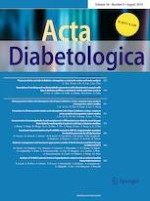Erschienen in:

06.04.2019 | Original Article
Accuracy of the 13C-glucose breath test to identify insulin resistance in non-diabetic adults
verfasst von:
Jorge Maldonado-Hernández, Azucena Martínez-Basila, Mario Enrique Rendón-Macías, Mardia López-Alarcón
Erschienen in:
Acta Diabetologica
|
Ausgabe 8/2019
Einloggen, um Zugang zu erhalten
Abstract
Aims
To assess the validity of the 13C-glucose breath test (13C-GBT) to identify insulin resistance (IR) in non-diabetic individuals, using hyperinsulinemic–euglycemic clamps as gold standard. This validity was compared with that of other IR surrogates.
Methodology
Non-diabetic adults were studied in a cross-sectional design. In a first appointment, oral glucose tolerance tests were conducted simultaneously with 13C-GBTs. Oral 75 g glucose dissolved in 150 ml water, followed by 1.5 mg/Kg body weight U-13C-glucose dissolved in 50 ml water, was administered. Breath and blood samples were collected at baseline and at 30-min intervals. The percentages of glucose-oxidized dose at given periods were calculated. Clamps were conducted a week later. A clamp-derived M value ≤ 6.0 mg/kg*min was used as cut-off. ROC curves were constructed for 13C-GBT, fasting insulin, HOMA, and ISI-composite.
Results
Thirty-eight subjects completed the study protocol. The correlation coefficient between the 13C-GBT derived glucose-oxidized dose at 180 min and M values was 0.524 (p = 0.001). The optimal value to identify IR with the 13C-GBT was 4.23% (AUC 0.81; 95CI 0.66, 0.96; accuracy 0.82, 95CI 0.66, 0.92). The 13C-GBT sensitivity (0.88) was higher than HOMA and fasting insulin sensitivities (0.83 and 0.75 respectively), while their specificities were comparable (0.71, 0.71, and 0.79, respectively). The sensitivity of ISI-C was higher (0.92) than that of the 13C-GBT, but its specificity was poor (0.36). The accuracy of the 13C-GBT was superior to that of the other studied surrogates.
Conclusions
The 13C-GBT is a valid and accurate method to detect IR in non-diabetic adults. Therefore, it is potentially useful in clinical and community settings.